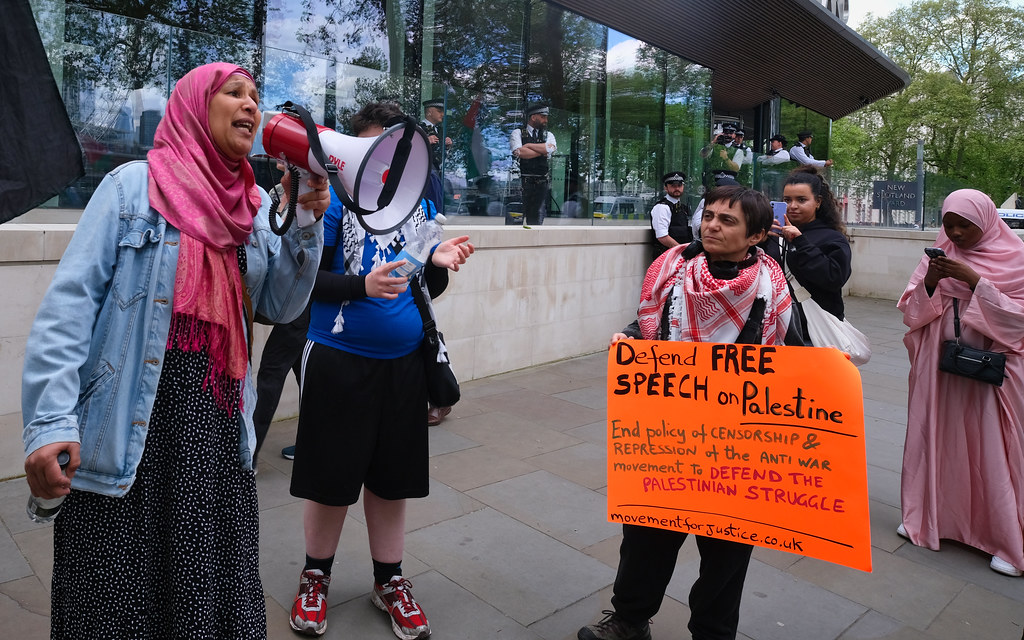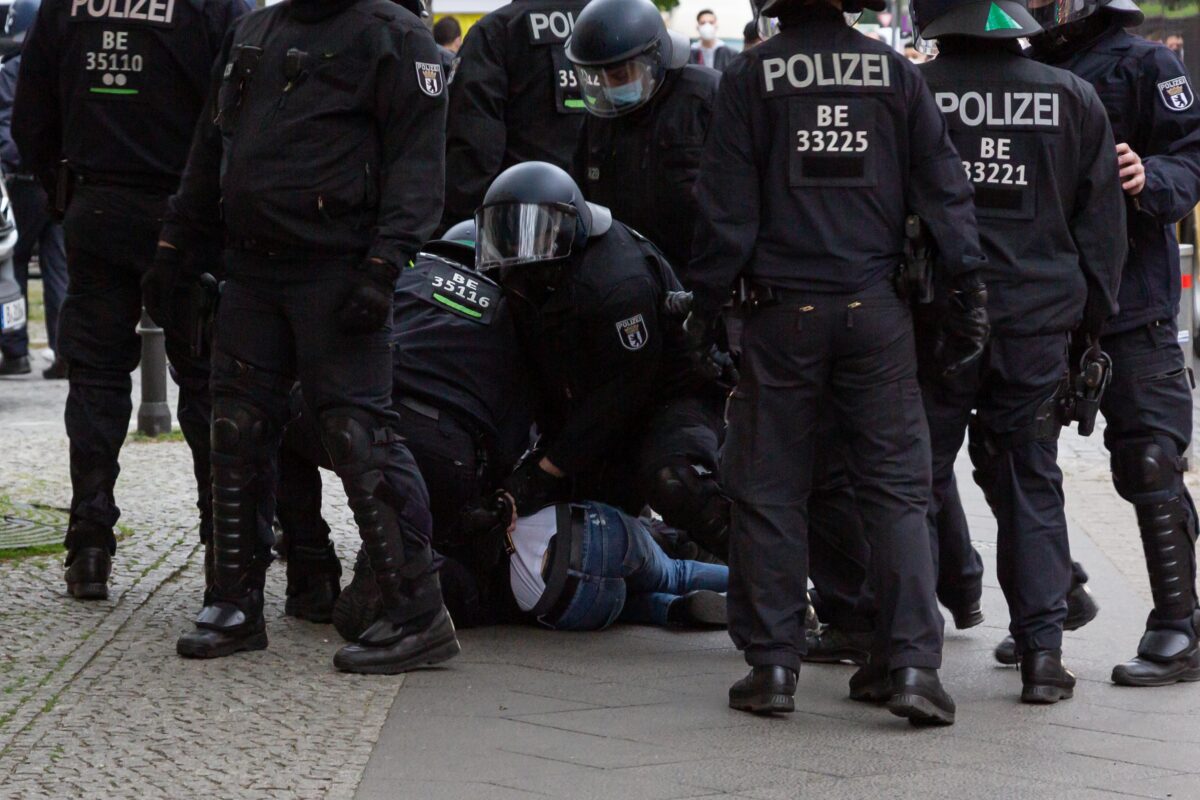Two recent reports by the Bundesverband der Recherche- und Informationsstellen Antisemitismus (RIAS) have claimed that antisemitism has skyrocketed in Germany since October 7th. These numbers have been reported on by German media, who have taken RIAS at its word, most recently in a documentary by the public television broadcaster ZDF. In a political climate where even slogans such as “stop the genocide” are made controversial, these statistics appear to provide methodologically-sound justification for claims of rampant Jew-hatred. Looking at the content of the reports, however, leaves serious doubt as to the reliability of RIAS’ claims.
On October 20th, RIAS published a preliminary report claiming 202 verified antisemitic incidents between October 7th and 15th. At the end of November, they then released a second, more thorough report which reported 994 verified antisemitic incidents across Germany between October 7th and November 9th. This second report includes the incidents from the first, and adds further analysis and a longer time-frame in its consideration. These incidents were mostly reported through local bodies, of which Bundesverband RIAS acts as the umbrella organisation.
Antisemitism statistics come primarily from two different sources in Germany. One is police statistics which, as Israeli-German activist Iris Hefets noted in a recent speech, will be drastically manipulated by the widespread arrests of Palestine-solidarity activists over the past months. This includes Hefets’ own multiple arrests, which would likely count as multiple antisemitic incidents.
Even under better circumstances, there are reasons to be wary of police hate-crime statistics. This makes an honest appraisal of RIAS’s work – which is the other source for such statistics – all the more important. RIAS is also important for its connections to the German federal government, which regularly uses its statistics in its strategies against antisemitism. The government funds RIAS through the Federal Government Commissioner for Jewish Life in Germany and the Fight against Antisemitism. The reports themselves note that they receive funding from the federal “Live Democracy!” program, and the Federal Ministry of the Interior and Home Affairs.
Problems with RIAS’ Methodology
RIAS’ methodology suffers for its lack of clarity. The first obvious issue is to consider what they mean by “verified” antisemitic incidents. At no point in either report do the unnamed authors specify what this verification process entails, what standards are used, or who is carrying it out. This lack of clarity casts doubts over their numbers altogether.
Similarly, there is no attempt to clarify or define what constitutes “Israel-related antisemitism”, which the second report states was present in 87% of incidents. This is reflective of the reports’ lack of description regarding what antisemitism is. In fairness, this is at least partially the result of the total lack of citations or bibliography.
Looking at older RIAS publications, it becomes clear that they support the International Holocaust Remembrance Alliance definition of antisemitism (IHRA definition), and have openly used it in past reports. It seems a reasonable assumption that they use the IHRA definition for this report as well.
The many issues with the IHRA definition have been discussed elsewhere, with the European Legal Support Center (ELSC) releasing their own report – with transparent methodology, I would add – which documented 53 cases when the definition was used to repress Palestine solidarity. The IHRA definition recently gained notice here in Berlin when protests and widespread criticism forced the city’s Senate to withdraw a proposed clause which would have forced artists with state funding to sign onto it.
The use of the IHRA definition to decide what would constitute an antisemitic incident risks inflating the numbers. This has been seen in the Canadian context, as written about by the sociologist Sheryl Nestel in her research report about the antisemitic statistics gathered by B’nai Brith Canada.
Nestel also critiques B’nai Brith for its lack of transparency regarding the content of reported incidents. She compares this to the American Anti-Defamation League’s antisemitism statistics which includes an online database listing all the incidents they report (although Jewish Currents has written critically about the ADL’s statistics for other reasons, it is worth noting). In this regard, RIAS is intransparent as in the Canadian example.
RIAS could be forgiven for not giving a detailed description of each of the 994 incidents they claim to have verified, and instead, could have provided a large sample of fleshed out cases or examples. Instead, they only quickly mention various incidents in-text and provide selective examples to the reader.
To put it in numbers, of the 202 incidents in the first report, they provide 21 examples, just over 10%. For the second report they give 25 examples of 994 incidents. Considering that the incidents which make up the first report are included in the larger scope of the second report, we can be generous and combine the examples from the two reports (none of which overlap). We find that between the two reports RIAS provided 46 examples for the 994 antisemitic incidents they report, meaning they only provide the reader with 4.6% of incidents. Currently, there is no published information regarding the other 95.4% of incidents the reports claim to be about.
This lack of transparency means that RIAS’ process for deciding what constitutes an antisemitic incident is incredibly important. Unfortunately, we have already seen how intransparent this process is as well. Even with this limited base of examples to evaluate how RIAS decides what constitutes antisemitism, though, we find extremely problematic examples. For instance, there are cases which might be distasteful, but it is unclear how they are to be considered antisemitic.
To quote one such case in full, on October 8 in Kiel: “At a solidarity rally with Israel, several participants were spat at by a group.” The fact that this is one of the only 46 examples of the antisemitic incidents which RIAS is reporting, highlights how unhelpful their few descriptions are. Here, RIAS presents no information that those attacked were Jewish, and so seems to claim that any person attacked for their participation in a pro-Israel event is in fact the victim of antisemitism. Given their opaque verification process, it is also unclear how they know this actually happened, as no sources are mentioned.
A similar thread can be seen from many of the examples of antisemitic gatherings/assemblies, of which RIAS states 177 took place. In their first report, RIAS admits that at “individual smaller events, greater care was taken to avoid antisemitic statements, either by the organizers or due to assembly requirements and bans.” RIAS says that this shows that “differences in the articulation of antisemitism could […] be observed”. Reading between the lines, it appears that some of the rallies did not include utterances which RIAS considers antisemitic language, but were nonetheless counted as antisemitic incidents, presumably due to their pro-Palestinian nature. Of course, if RIAS had released the full list of incidents, it would be clear whether or not this was the case.
RIAS’ understanding of antisemitism is also visible through its focus on attacks against the Israeli flag, literally an Israeli-state symbol. Of the 46 examples given, 7 are attacks on the Israeli flag. RIAS even tells us in the second report that “140 incidents were reported in which Israeli flags […] were damaged or stolen.” These are included as antisemitic incidents, the statistical equivalent to an attack on an actual Jew. By their own numbers, 14% of RIAS’ antisemitic incidents are about the Israeli flag.
It must be said that RIAS’ emphasis on attacks against the Israeli flag being considered antisemitic feel particularly ironic, considering that for several weeks there were de facto bans on waving Palestinian flags throughout much of Berlin. Those who dared to publicly hold these flags were frequently arrested by the police.
Even when discussing actual and dangerous antisemitism, such as when molotov cocktails were thrown at a Berlin synagogue, RIAS’ reports have methodological problems. The reports fail to differentiate between such serious incidents and verbal antisemitic attacks or online statements in their overall numbers. The latter deserve to be taken seriously, but they are vastly different in their severity from physical attacks. The methodological choice of combining all these together in their numbers allows RIAS to create dramatic statistics, but at the cost of clarity regarding antisemitism in Germany.
These methodological questions and issues are largely sidestepped throughout the reports. The first report opens by stating that October 7th “will go down in history as the day with the most Jewish casualties since 1945.” Readers are left to decide for themselves whether references to the Holocaust are an accurate substitute for methodology.
Why are these statistics so dangerous?
There is real antisemitism in Germany, and there have been real antisemitic incidents since October 7th. We do not need RIAS’ reports to know this. Methodologically flawed statistics such as these, though, have the effect of mystifying the state of antisemitism in Germany. The blatant flaws in these statistics could be used by someone to argue that there is no real antisemitism here, that it is all made up.
Simultaneously, by stuffing the numbers with attacks on Israeli flags and the like, their overblown numbers create a climate of fear which makes accurate assessments of Jewish safety in Germany difficult. Especially considering the familial trauma of many Jews living here, fear mongering about antisemitism is emotionally harmful.
Flawed statistics also mean that we are left with little to no reliable information about the actual number or origin of antisemitic incidents. Instead, we have claims – such as the one in RIAS’ first report – that 2% of antisemitic incidents come from a far-right political ideology. A vague and dangerous statement, it could be used to dismiss right-wing antisemitism, just as the AfD are posed to win regional elections in various German states.
But reports such as this one are arguably most dangerous for other minorities, especially Palestinians and Muslims, who are regularly scapegoated by German media and politicians as the source of hatred towards Jews. These reports are published in a context of skyrocketing Islamophobia and anti-Palestinian racism, after all. In focusing on Palestine-solidarity, these reports contribute to a racist atmosphere which justifies the calls for mass deportations, whether they come from the AfD or the SPD. As Anna-Esther Younes has shown, claims of “imported antisemitism” date back to the early 2000’s, when Germany’s new citizenship rules provoked a crisis regarding who could become German. It seems unlikely to be a coincidence that debates over citizenship are prominent again today.
These divide-and-rule tactics between Jews and Palestinians/Muslims – arguments which claim to protect the former by attacking the latter – are harmful to genuine anti-racist movements. Within the actual Palestine-solidarity movements in Berlin, though, people have seen through these claims. The Berlin-based Jewish Antifascist Bund released a statement to this effect back in October, around the same time RIAS published the first report, under the appropriate title, “You Do Not Protect Us”. The Bund’s statement critiqued the same claims that RIAS attempted to support with statistics. In the end, though, statistics devoid of methodology are not better than claims devoid of statistics.




